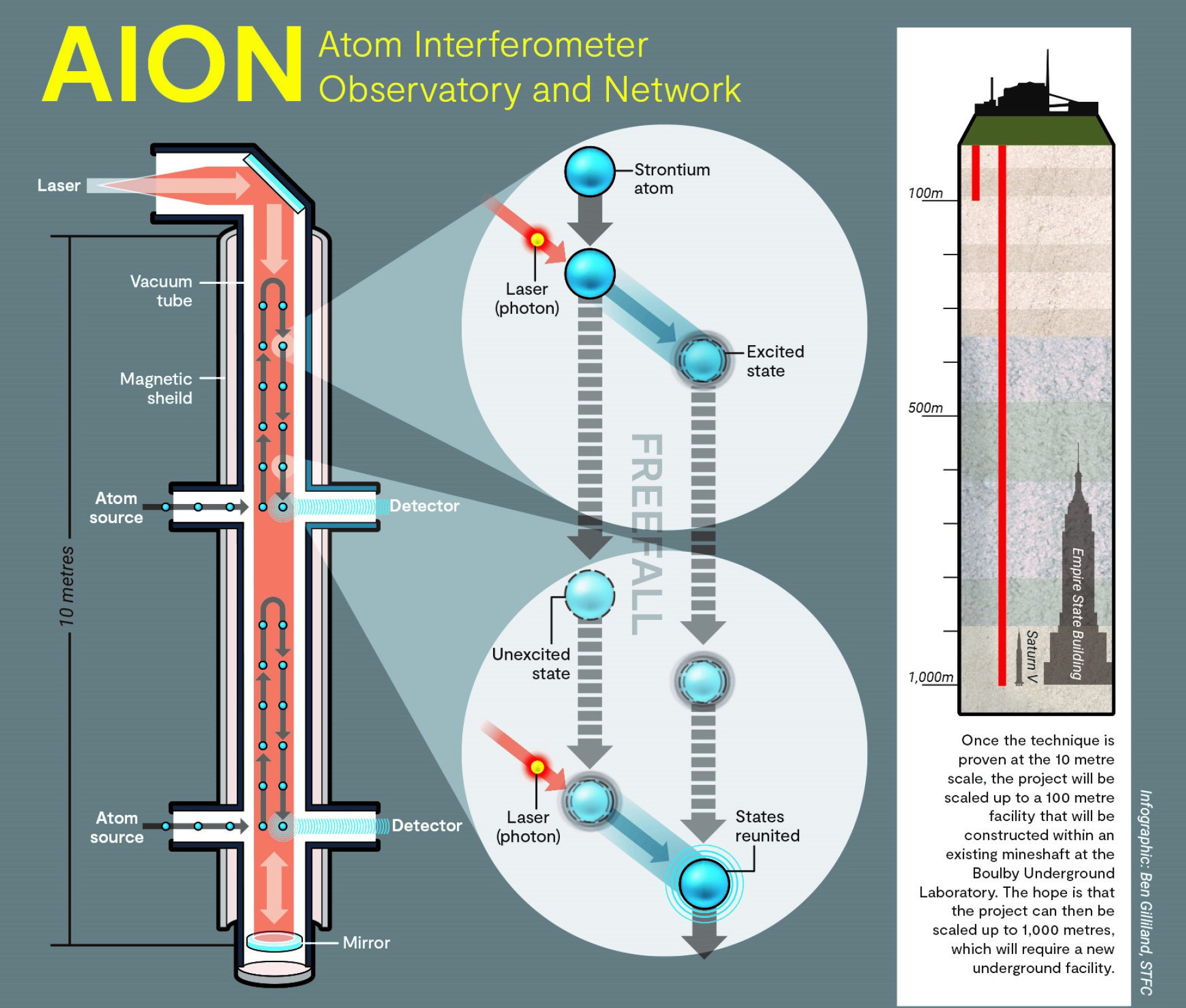
Merging massive objects, like black holes, create gravitational waves
Global S&T Development Trend Analysis Platform of Resources and Environment
| £7.2m quantum network will develop technology to probe Universe’s mysteries | |
| admin | |
| 2021-01-13 | |
| 发布年 | 2021 |
| 语种 | 英语 |
| 国家 | 英国 |
| 领域 | 资源环境 |
| 正文(英文) | 
Merging massive objects, like black holes, create gravitational waves 
The Atom Interferometry Observatory and Network (AION), led by Imperial researchers, will accelerate searches for dark matter and gravitational waves. The UKRI Science Technology and Facilities Council (STFC) has provided £7.2m of initial funding for the project within its new Quantum Technologies for Fundamental Physics programme. AION is a uniquely interdisciplinary mission that will harness cold atom technologies to address key issues in fundamental physics, astrophysics and cosmology that can be realised in the next few decades. Professor Oliver Buchmueller AION will enable a ground-breaking search for ultra-light candidates for dark matter – a mysterious substance that makes up 85 percent of the ‘missing’ matter of the Universe. It will also pave the way for the exploration of gravitational waves – ripples in spacetime created by huge astronomical events – in a previously inaccessible range, opening a new window on the mergers of massive black holes and novel physics in the early Universe. An interdisciplinary team of researchers, engineers and PhD students from the particle physics, ultra-cold atom and astronomy communities will develop the technology to build and reap the scientific rewards from the first large-scale atom interferometer in the UK. Interfering atomsInterferometers measure any changes to ultra-cold atoms as they freefall in a vacuum and split into two different states. If something disturbs one of the states as it falls, there will be a measurable ‘interference’ when the states recombine. Gravitational waves would cause interference by changing the shape of space itself. Dark matter would cause changes to the properties of the atoms. The UKRI funding will support the design of a 10m atom interferometer, leading towards the construction of the instrument in Oxford, and paving the way for larger-scale experiments in the UK in the future. Members of the consortium will also contribute to MAGIS, a partner experiment situated at the Fermi National Laboratory in the USA, networking the two instruments together. 
AION Principal Investigator Professor Oliver Buchmueller, from the Department of Physics at Imperial, said: “We are delighted that the UKRI and STFC will fund the novel AION project. AION is a uniquely interdisciplinary mission that will harness cold atom technologies to address key issues in fundamental physics, astrophysics and cosmology that can be realised in the next few decades.” A leading role in large-scale interferometryThe AION project is a consortium led by Imperial College London and includes the University of Birmingham, the University of Cambridge, Kings College London, the University of Liverpool, the University of Oxford, and the STFC Rutherford Appleton Laboratory. In addition, the project is in partnership with UK National Quantum Technology Hub in Sensors and Timing, Birmingham, UK, the MAGIS Collaboration, US, and the Fermi National Accelerator Laboratory, US. The Imperial team is led by Professor Oliver Buchmueller, Professor Ben Sauer, Professor Michael Tarbutt and Dr Richard Hobson from the Department of Physics’ High Energy Physics and Quantum Optics and Laser Science research groups. They will focus on the challenge of minimising atom shot noise – fluctuations that can affect the precision of the experiment – through the fast creation of large, cold and squeezed samples of the element strontium, undertaking data analysis and theoretical interpretation. The new funding will also establish for Imperial a leading role in large-scale atom interferometry for fundamental physics research, as the AION consortium looks towards possible 100m- and km-scale terrestrial detectors as well as a future space mission. Quantum clocksImperial researchers are also involved in a second quantum technologies project announced today: a £3.7m scheme led by the University of Birmingham to exploit the precision of atomic, molecular and ion clocks – the most precise instruments ever built. The clocks will be linked in a network, so that if a variation of the ‘ticking’ of the hyper-sensitive clocks is observed, it will provide the first direct and quantitative evidence of new physics at the quantum level. |
| URL | 查看原文 |
| 来源平台 | Imperial College London |
| 文献类型 | 新闻 |
| 条目标识符 | http://119.78.100.173/C666/handle/2XK7JSWQ/310342 |
| 专题 | 资源环境科学 |
| 推荐引用方式 GB/T 7714 | admin. £7.2m quantum network will develop technology to probe Universe’s mysteries. 2021. |
| 条目包含的文件 | 条目无相关文件。 | |||||
| 个性服务 |
| 推荐该条目 |
| 保存到收藏夹 |
| 查看访问统计 |
| 导出为Endnote文件 |
| 谷歌学术 |
| 谷歌学术中相似的文章 |
| [admin]的文章 |
| 百度学术 |
| 百度学术中相似的文章 |
| [admin]的文章 |
| 必应学术 |
| 必应学术中相似的文章 |
| [admin]的文章 |
| 相关权益政策 |
| 暂无数据 |
| 收藏/分享 |
除非特别说明,本系统中所有内容都受版权保护,并保留所有权利。
修改评论